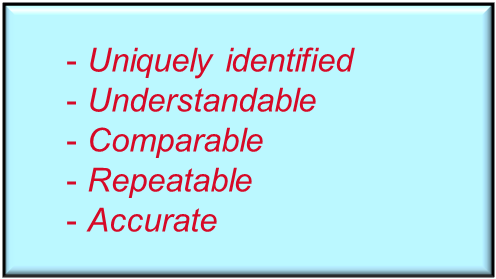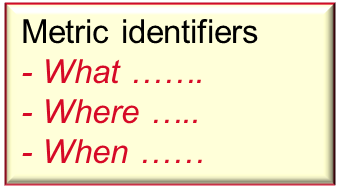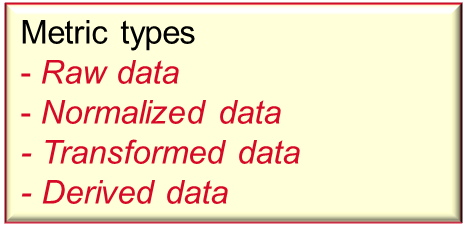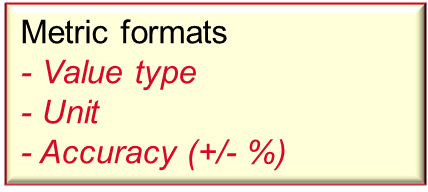Performance measurement metrics
Metrics are the output from performance measurements.
To produce metrics with high quality all captured performance data must comply to a number of requirements.
This page explains different types performance data and the requirements on captured performance data.
General requirements
Performance metrics must comply to five general requirements.

General requirements on metrics
1. Uniquely identified
The naming of metrics must be unique to avoid name conflicts
2. Understandable
Metrics should be accompanied by specifications that make them easy to understand.
3. Comparable
Metrics should be accompanied by recording conditions and processing methods to be comparable.
4. Repeatable
Metrics should specify test case specifications, test tool specifications, and test object specifications.
This is a basic requirement for regression tests of performance.
5. Accurate
Metrics should be accompanied by data recording methods and configurations .
Metric identifiers
Every measurement value must have three identifying attributes.

Metric identifiers
1. What
What does a metric value represent?
2. Where
Where is the metric value captured, i.e. where is the measurement point of a metric value?
3. When
When was the metric value captured? Performance measurements generate long time series of measurement data. Therefore is the point in time critical for comparisons with other metrics.
Performance metrics are of no value if they are not accompanied by the three identifiers, since you can't tell what they represent.
Metric types
Metrics belong to one of four types.

Metric types
1. Raw data
Raw data are captured data in its original format. Raw data can in some cases be used as metrics in its final format, such as response time.
2. Normalized data
Normalized data are metric figures that relates to normalizing factor, such as transactions per second.
3. Transformed data
Transformed data are metric figures transformed from the recorded value format to another value format, such as memory size transformed to a percentage of total memory.
4. Derived data
Derived data are metric figures resulting from computations based on other captured metrics. Key Performance Indicators are typically derived metrics.
Metric formats
Metrics values are described with three format attributes.

Metric formats
1. Value type
Value type tells what a metric value represents, such as time, counters, or other.
2. Unit
Is the quantity format a metric value, such as millisecond for time.
3. Accuracy
The precision of a metric value.
Measurement conditions
Valid measurement conditions are fundamental to the quality of metric values.
![]()
Measurement conditions
The measured conditions on the SUT when requested measurement values were captured are used to separate valid measurement values from invalid.
Proceed to Performance Measurement Conditions

